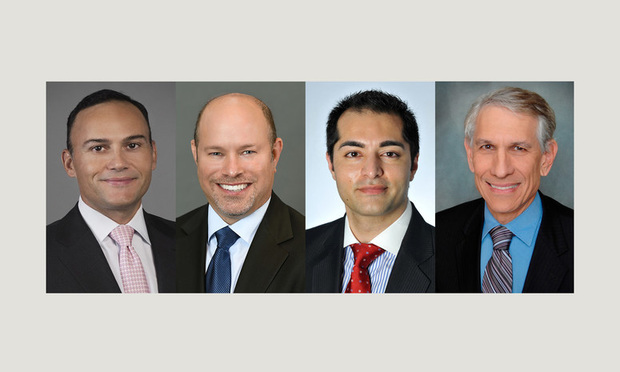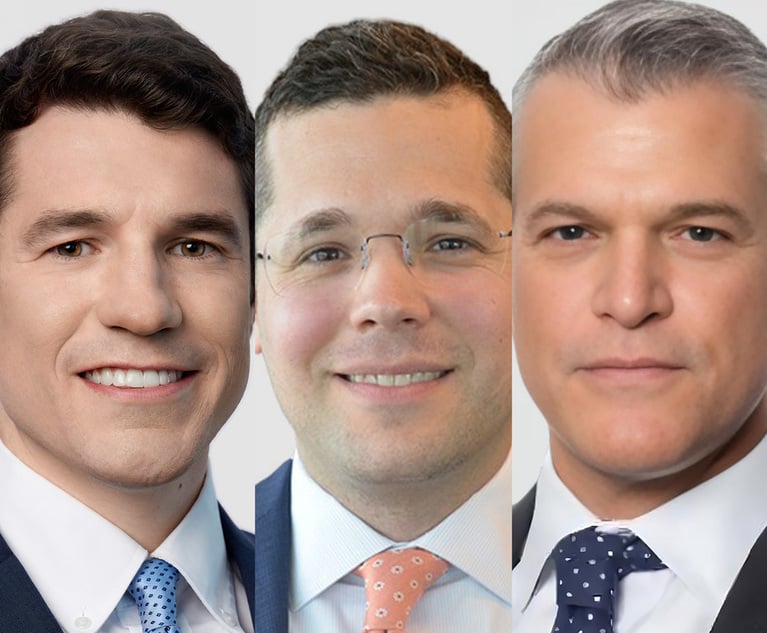New EB-5 Regulations Carry Significant Consequence to the South Florida Market
As a result of a new agency rule, potential EB-5 investors will be scurrying to invest in the EB-5 program in rapid fashion, many of whom desire to invest in the South Florida economy and emigrate to South Florida.
August 29, 2019 at 09:10 AM
5 minute read
 L-R: Julian Montero, Roger Bernstein, Rohit Kapuria, and Ronald Fieldstone.
L-R: Julian Montero, Roger Bernstein, Rohit Kapuria, and Ronald Fieldstone.As a result of a new agency rule, potential EB-5 investors will be scurrying to invest in the EB-5 program in rapid fashion, many of whom desire to invest in the South Florida economy and emigrate to South Florida. On July 24, U.S. Citizenship and Immigration Services (USCIS) published a final rule amending the Department of Homeland Security (DHS) regulations governing the employment-based, fifth preference (EB-5) immigrant investor classification and associated regional centers.
Under the EB-5 program, qualified individuals are eligible to apply for lawful permanent residence in the United States if they make the necessary investment in a commercial enterprise in the United States and create or, in certain circumstances, preserve 10 full-time jobs for qualified U.S. workers.
The final rule provides, among a number of other changes:
- Priority date retention to certain EB-5 investors (this means that if an investor desires to redirect his investment to another project following approval of the initial I-526 petition, the initial priority date of such application will be preserved);
- An increase in the required minimum investment amounts;
- An amendment to the definition of a targeted employment area (TEA) and
- A clarification on USCIS procedures for the removal of conditions on an investor's permanent residence.
The final rule becomes effective on Nov. 21.
Fortunately, the regulations are NOT retroactive and investors have until Nov. 20 to file I-526 petitions under the existing regulations. Undoubtedly, this will result in a significant uptick in EB-5 investment activity in South Florida as investors scramble to lock in the lower $500,000 minimum investment.
Of major import, the rule increases the minimum investment amount in a TEA from $500,000 to $900,000 and increases the standard investment amount from $1 million to $1.8 million. The price increases were widely anticipated as the investment amounts had not been increased since the EB-5 program's inception almost 30 years ago. Most industry analysts feel the market will absorb the price increase for the TEA designated projects given that over the past five years, demand for the EB-5 visa far exceeded the 10,000 per year visa allocation. Additionally, because of the increase in the investment threshold, projects will need approximately 45% less investors.
Perhaps equally important, the final rule eliminates the ability of a state to confirm TEA designation; instead, DHS will make such designations directly, using a uniform but far more stringent standard. Stripping the designation authority away from each state and giving DHS sole authority to designate what areas qualify as TEA's was a consequence of what some industry and elected officials felt was a disproportionate investment in low unemployment urban centers. DHS felt that states were far too generous in granting TEA designations using an analysis that currently permits an aggregation of contiguous census tracts instead of adjacent census tracts (the latter of which will now be required by DHS). A Government Accountability Office study recently determined that 97% of qualified investment funds were flowing into high density urban targeted employment areas. As a result, the new rule seeks to limit gerrymandering of contiguous census tracts in an effort to direct investments into truly high unemployment and rural areas.
Barring a legislative change or a lawsuit enjoining the final rule, as of Nov. 21, this will be the new reality. The new rule is likely to reduce the number of EB-5 projects in major metropolitan jurisdictions. However, it is expected that South Florida will fare slightly better because of its unique geography (many downtown projects as well as midtown projects will still qualify under the new rule). Nevertheless the impact of the new rule will still be felt. According to a South Florida economist, Scott Barnhart, up to 70% or more of existing South Florida EB-5 projects may no longer qualify as TEA designations under the new rule.
The positive news is that South Florida will remain a top EB-5 market. Our region has experienced a significant influx of LatAm EB-5 investors over the last few years and this trend is likely to continue, despite the expected increase in investment amount. The primary driver for LatAm EB-5 investors continues to be socio-economic and political challenges felt in several LatAm countries. Furthermore, given its close cultural, geographic and economic ties to the region, South Florida will continue to be the primary beneficiary of capital from LatAm.
It is important to recognize the many benefits that a healthy EB-5 program represents to South Florida. The program will produce even more tangible economic benefits if Congress is able to pass meaningful and long-term legislative reform that provides visa backlog relief and a more timely adjudication of EB-5 petitions.
Roger Bernstein is a partner in Saul Ewing Arnstein & Lehr's Miami office and is vice chair of the firm's global immigration and foreign investment practice group.
Ronald R. Fieldstone is a partner in the firm's Miami office and serves as corporate/securities counsel for multifaceted industries involving EB-5 immigrant visa investor offerings.
Julian Montero is a partner in the firm's Miami office who represents clients in general business and transactional matters including cross-border transactions. He regularly advises foreign investors on strategies for successfully acquiring or establishing businesses in the United States.
Rohit Kapuria is an attorney in the firm's Chicago office where he focuses on corporate and securities law, including handling private offerings under the EB-5 investor visa program.
This content has been archived. It is available through our partners, LexisNexis® and Bloomberg Law.
To view this content, please continue to their sites.
Not a Lexis Subscriber?
Subscribe Now
Not a Bloomberg Law Subscriber?
Subscribe Now
NOT FOR REPRINT
© 2025 ALM Global, LLC, All Rights Reserved. Request academic re-use from www.copyright.com. All other uses, submit a request to [email protected]. For more information visit Asset & Logo Licensing.
You Might Like
View All
Initial Steps to Set Up a Fla. Appeal: Your Future Self (or Appellate Attorney) Will Thank You
6 minute read
Divorce Timing Is Everything: Waiting for the New Year May Have Its Advantages
4 minute read
Motions for Summary Judgment and Discovery: The 2021 Rule Changes Continue to Emerge
5 minute read
Trending Stories
- 1Meta Hires Litigation Strategy Chief, Tapping King & Spalding Partner Who Was Senior DOJ Official in First Trump Term
- 2Courts Beginning to Set Standards for Evidence Relying upon Artificial Intelligence
- 3First-Degree Murder Charge May Not Fit Mangione Case
- 4Legal Tech's Predictions for Legal Ops & In-House in 2025
- 5SDNY US Attorney Damian Williams Lands at Paul Weiss
Who Got The Work
Michael G. Bongiorno, Andrew Scott Dulberg and Elizabeth E. Driscoll from Wilmer Cutler Pickering Hale and Dorr have stepped in to represent Symbotic Inc., an A.I.-enabled technology platform that focuses on increasing supply chain efficiency, and other defendants in a pending shareholder derivative lawsuit. The case, filed Oct. 2 in Massachusetts District Court by the Brown Law Firm on behalf of Stephen Austen, accuses certain officers and directors of misleading investors in regard to Symbotic's potential for margin growth by failing to disclose that the company was not equipped to timely deploy its systems or manage expenses through project delays. The case, assigned to U.S. District Judge Nathaniel M. Gorton, is 1:24-cv-12522, Austen v. Cohen et al.
Who Got The Work
Edmund Polubinski and Marie Killmond of Davis Polk & Wardwell have entered appearances for data platform software development company MongoDB and other defendants in a pending shareholder derivative lawsuit. The action, filed Oct. 7 in New York Southern District Court by the Brown Law Firm, accuses the company's directors and/or officers of falsely expressing confidence in the company’s restructuring of its sales incentive plan and downplaying the severity of decreases in its upfront commitments. The case is 1:24-cv-07594, Roy v. Ittycheria et al.
Who Got The Work
Amy O. Bruchs and Kurt F. Ellison of Michael Best & Friedrich have entered appearances for Epic Systems Corp. in a pending employment discrimination lawsuit. The suit was filed Sept. 7 in Wisconsin Western District Court by Levine Eisberner LLC and Siri & Glimstad on behalf of a project manager who claims that he was wrongfully terminated after applying for a religious exemption to the defendant's COVID-19 vaccine mandate. The case, assigned to U.S. Magistrate Judge Anita Marie Boor, is 3:24-cv-00630, Secker, Nathan v. Epic Systems Corporation.
Who Got The Work
David X. Sullivan, Thomas J. Finn and Gregory A. Hall from McCarter & English have entered appearances for Sunrun Installation Services in a pending civil rights lawsuit. The complaint was filed Sept. 4 in Connecticut District Court by attorney Robert M. Berke on behalf of former employee George Edward Steins, who was arrested and charged with employing an unregistered home improvement salesperson. The complaint alleges that had Sunrun informed the Connecticut Department of Consumer Protection that the plaintiff's employment had ended in 2017 and that he no longer held Sunrun's home improvement contractor license, he would not have been hit with charges, which were dismissed in May 2024. The case, assigned to U.S. District Judge Jeffrey A. Meyer, is 3:24-cv-01423, Steins v. Sunrun, Inc. et al.
Who Got The Work
Greenberg Traurig shareholder Joshua L. Raskin has entered an appearance for boohoo.com UK Ltd. in a pending patent infringement lawsuit. The suit, filed Sept. 3 in Texas Eastern District Court by Rozier Hardt McDonough on behalf of Alto Dynamics, asserts five patents related to an online shopping platform. The case, assigned to U.S. District Judge Rodney Gilstrap, is 2:24-cv-00719, Alto Dynamics, LLC v. boohoo.com UK Limited.
Featured Firms
Law Offices of Gary Martin Hays & Associates, P.C.
(470) 294-1674
Law Offices of Mark E. Salomone
(857) 444-6468
Smith & Hassler
(713) 739-1250






